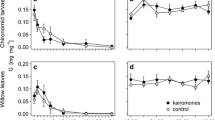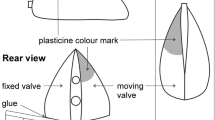Abstract
Introduction of sculpins into a stream previously devoid of these predators significantly reduced drift rate of Gammarus pulex. The drift of insect larvae was not affected. High amounts of exudates after implantation of sculpins were probably responsible for the low number of drifting G. pulex specimens. Laboratory experiments confirmed reduced locomotory activity of G. pulex when exposed to caged sculpins, an observation that excludes reduced drift activity as a result only of predation.
The average size of drifting G. pulex specimens was larger during the night than during the day. This result is in accordance with the hypothesis that large individuals should, in relation to small ones, turn nocturnal because of greater predation risk during daytime. Presence of sculpins did not alter the size composition of drifting G. pulex.
Similar content being viewed by others
References
Allan, J. D., 1978. Trout predation and the size composition of stream drift. Limnol. Oceanogr. 23: 1231–1237.
Allan, J. D., 1982. The effects of reduction in trout density on the invertebrate community of a mountain stream. Ecology 63: 1444–1455.
Allan, J. D., 1983. Food consumption by trout and stoneflies in a Rocky Mountain stream, with comparison to prey standing crop. In: T. D. Fontaine & S. M. Bartell, (eds.), Dynamics of lotic ecosystems. Ann Arbor Science Publ., Ann Arbor:: 371–390.
Allan, J. D., 1984. The size composition of invertebrate drift in a Rocky Mountain stream. Oikos 43: 68–76.
Allen, K. R., 1951. The Horokiwi stream: a study of a trout population. New Z. mar. Dep. Fish. Bull. 10: 1–238.
Andreasson, S., 1971. Locomotory activity patterns of Cottus poecilopus Heckel and C. gobio L. (Pisces). Oikos 20: 78–94.
Andreasson, S., 1971. Feeding habits of a sculpin (Cottus gobio L. Pisces) population. Rep. Inst. Freshwat. Res. Drottningholm 51: 5–30.
Bengtsson, G., 1982. Energetic costs of amino acids exudation in the interaction between the predator Gammarus pulex L. and the prey Asellus aquaticus L. J. Chem. Ecol. 8; 1271–1281.
Brönmark, C. & B. Malmqvist, 1986. Interactions between the leech Glossiphonia complanata and its gastropod prey. Oecologia (Berl.) (in press).
Busdosh, M., G. A. Robilliard, K. Tarbox & C. L. Beehler, 1982. Chemoreception in an arctic amphipod crustacean: A field study. J. exp. mar. Biol. Ecol. 62: 261–269.
Corkum, L. D. & H. F. Clifford, 1980. The importance of species associations and substrate types to behavioural drift. In J. F. Flannagan & K. E. Marshall, (eds.), Advances in Ephemeroptera biology. Plenum Press, New York: 331–341.
Flecker, A. S., 1984. The effects of predation and detritus on the structure of a stream insect community: a field test. Oecologia (Berl.) 64: 300–305.
Flecker, A. S. & J. D. Allan, 1984. The importance of predation, substrate and spatial refugia in determining lotic insect distributions. Oecologia (Berl.) 64: 306–313.
Goedmakers, A. & S. Pinkster, 1981. Population dynamics of three gammarid species (Crustacea, Amphipoda) in a French chalk stream. Bijdr. Dierk. 51: 145–180.
Healey, M., 1984. Fish predation on aquatic insects. In V. H. Resh & D. M. Rosenberg, (eds.), The ecology of aquatic insects. Praeger Publ., New York: 255–288.
Hultin, L., 1971. Upstream movements of Gammarus pulex pulex (Amphipoda) in a South Swedish stream. Oikos 22: 329–347.
Macan, T. T. & J. C. Mackereth, 1957. Notes on Gammarus pulex in the English Lake District. Hydrobiologia 9: 1–12.
Malmqvist, B., L. M. Nilsson & B. S. Svensson, 1978. Dynamics of detritus in a small stream in southern Sweden and its influence on the distribution of the bottom animal communities. Oikos 31: 3–16.
Newman, R. M. & T. F. Waters, 1984. Size-selective predation on Gammarus pseudolimnaeus by trout and sculpins. Ecology 65: 1535–1545.
Nilsson, L. M., 1977. Energetics and population dynamics of Gammarus pulex L. Amphipoda. Ph. D- Diss., Lund Univ., Sweden.
Otto, C., 1971. Growth and population movements of Potamophylax cingulatus (Trichoptera) larvae in a South Swedish stream. Oikos 22: 292–301.
Otto, C., 1974. Growth and energetics in a larval population of Potamophylax cingulatus (Steph.) (Trichoptera) in a South Swedish stream. J. Anim. Ecol. 43: 339–361.
Otto, C., 1976. Size, growth, population density and food of brown trout Salmo trutta L. in two sections of a south Swedish stream. J. Fish Biol. 8: 477–488.
Otto, C. & P. Sjöström, 1983. Cerci as antipredatory attributes in stonefly nymphs. Oikos 41: 200–204.
Peckarsky, B. L., 1980. Predator-prey interactions between stoneflies and mayflies: behavioral observations. Ecology 61: 932–943.
Peckarsky, B. L., 1982. Aquatic insect predator-prey relations. BioScience 32: 261–266.
Reice, S. R., 1983. Predation and substratum: factors in lotic community structure. In T. D. Fontaine III & S. M. Bartell, (eds.), Dynamics of lotic ecosystems. Ann Arbor Science Publ., Ann Arbor: 325–345.
Ringler, N. H., 1979. Selective predation by drift-feeding brown trout (Salmo trutta). J. Fish. Res. Bd Can. 36: 392–403.
Sih, A., 1982. Foraging strategies and the avoidance of predation by an aquatic insect, Notonecta hoffmanni. Ecology 63: 786–796.
Statzner, B. & A. Bittner, 1983. Nature and causes of migrations of Gammarus fossarum Koch (Amphipoda) — A field study using a light intensifier for the detection of nocturnal activities. Crustaceana 44: 271–291.
Stein, R. A., 1977. Selective predation, optimal foraging, and the predator-prey interaction between fish and crayfish. Ecology 58: 1237–1253.
Stein, R. A. & J. J. Magnuson, 1976. Behavioral response of crayfish to a fish predator. Ecology 57: 751–761.
Straskraba, M., 1965. The effects of fish on the number of invertebrates in ponds and streams. Mitt. int. Ver. Limnol. 13: 106–127.
Thorne, M. J., 1969. Behaviour of the caddis fly larva Potamophylax stellatus (Curtis) (Trichoptera). Proc. r. ent. Soc. Lond. 44: 91–110.
Townsend, C. R., 1980. The ecology of streams and rivers. Studies in Biology 122. Edward Arnold, Lond., 68pp.
Williams, D. D. & K. A. Moore, 1982. The effect of environmental factors on the activity of Gammarus pseudolimnaeus (Amphipoda). Hydrobiologia 96: 137–147.
Williams, D. D. & K. A. Moore, 1985. The role of semiochemicals to benthic community relationships of the lotic amphipod Gammarus pseudolimnaeus: a laboratory analysis. Oikos 44: 280–286.
Author information
Authors and Affiliations
Rights and permissions
About this article
Cite this article
Andersson, K.G., Brönmark, C., Herrmann, J. et al. Presence of sculpins (Cottus gobio) reduces drift and activity of Gammarus pulex (Amphipoda). Hydrobiologia 133, 209–215 (1986). https://doi.org/10.1007/BF00005592
Issue Date:
DOI: https://doi.org/10.1007/BF00005592




